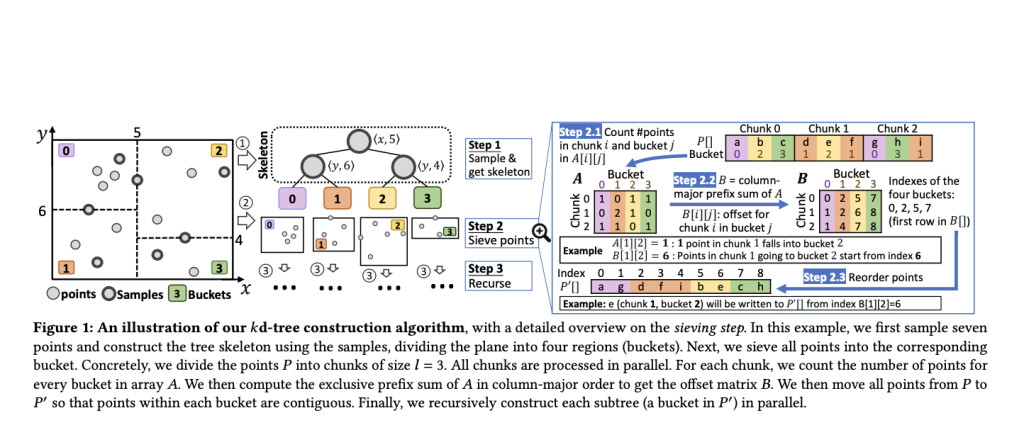

The exponential growth of multi-dimensional data across various fields, such as machine learning, geospatial analysis, and clustering, has posed significant challenges to traditional data structures. One such structure, the kd-tree, has long been a fundamental tool for managing high-dimensional datasets, supporting queries like nearest neighbors, range searches, and clustering analysis. However, the rapidly increasing size of data is pushing the limits of current kd-tree implementations, which struggle to keep up in terms of construction time, scalability, and update efficiency, especially in parallel computing environments. Existing solutions are either static, lacking update support, or exhibit poor scaling with today’s large datasets. This gap between widespread use and the need for efficiency in construction, updates, and queries underscores the challenges in leveraging kd-trees for high-performance applications.
The Pkd-Tree: An Innovative Solution
UC Riverside researchers propose the Pkd-tree (Parallel kd-tree), an innovative data structure that aims to address these challenges by introducing efficient parallelism both in theory and practice. The Pkd-tree is designed for efficient in-memory operations, supporting parallel construction, batch updates, and a variety of query types. This new approach enables significant improvements in handling large-scale multi-dimensional data compared to existing kd-tree variants. The core of the Pkd-tree is built on novel algorithms that ensure optimal work complexity, high parallelism, and efficient cache usage. Through a combination of advanced construction techniques and careful engineering, the researchers have created a kd-tree that remains not only theoretically sound but also highly performant in practical settings.
Technical Foundations and Benefits
The technical foundations of the Pkd-tree involve optimizing several key aspects of kd-tree construction and update mechanisms. The researchers devised a parallel construction algorithm that simultaneously minimizes work, span (representing parallel computation depth), and cache complexity. By determining the splitting hyperplane through a sophisticated sampling scheme and using a sieving mechanism to partition points into subspaces with minimal data movement, they ensure that the Pkd-tree remains balanced and optimized. Additionally, a reconstruction-based update process helps keep the tree weight-balanced without the need for full rebuilds after every modification. This approach yields a kd-tree structure that is not only efficient to build but also highly adaptable to dynamic datasets, allowing rapid insertion and deletion operations while maintaining the quality of query responses. Tests on synthetic and real-world datasets confirmed that the Pkd-tree outperforms state-of-the-art parallel kd-trees, delivering faster construction and update times while retaining or improving query efficiency.
Practical Impact and Results
The importance of the Pkd-tree lies in its ability to address practical limitations that have long hindered the scalability of kd-trees in parallel environments. In tests against well-established implementations such as CGAL and ParGeo, the Pkd-tree consistently demonstrated superior performance. For instance, when handling a dataset of one billion points across two dimensions, the Pkd-tree constructed the structure approximately 8 to 12 times faster than its closest competitors. Batch insertions and deletions were also significantly quicker, showcasing a speed increase of up to 40 times over existing methods like the Log-tree from ParGeo. These improvements are largely due to the PKD-tree’s novel use of weight balancing, which prevents the need for inefficient full tree reconstructions during updates, and its cache-efficient design, which ensures minimal data transfer during construction and updates. The Pkd-tree’s performance gains are particularly evident in environments that require frequent modifications, making it a valuable tool for dynamic, large-scale applications.
Conclusion
In conclusion, the PKD-tree represents a significant advancement in the field of data structures for managing multi-dimensional data. By combining theoretical efficiency with the practical performance, it closes the gap between the need for high-speed, large-scale data management and the limitations of traditional kd-tree implementations. The Pkd-tree’s ability to efficiently support both construction and dynamic updates, along with optimized query performance, makes it an ideal candidate for applications ranging from spatial databases to real-time machine learning pipelines. UC Riverside’s research has thus contributed a powerful new tool for data scientists and engineers working with massive datasets, enabling them to leverage kd-trees more effectively and efficiently in both parallel and dynamic environments.
Check out the Paper. All credit for this research goes to the researchers of this project. Also, don’t forget to follow us on Twitter and join our Telegram Channel and LinkedIn Group. If you like our work, you will love our newsletter.. Don’t Forget to join our 55k+ ML SubReddit.
[FREE AI WEBINAR] Implementing Intelligent Document Processing with GenAI in Financial Services and Real Estate Transactions– From Framework to Production
The post UC Riverside Researchers Propose the Pkd-tree (Parallel kd-tree): A Parallel kd-tree that is Efficient both in Theory and in Practice appeared first on MarkTechPost.
Source: Read MoreÂ

